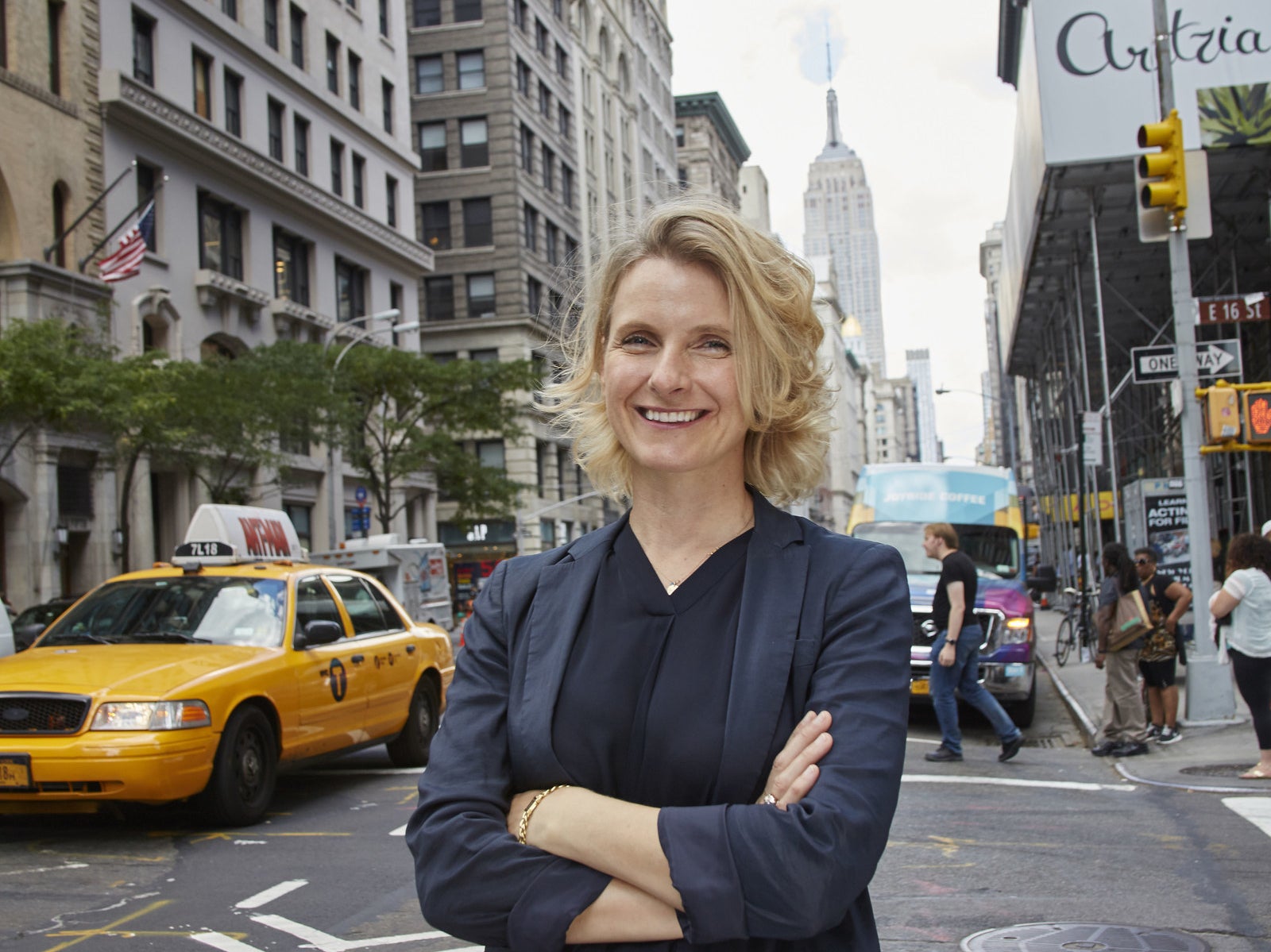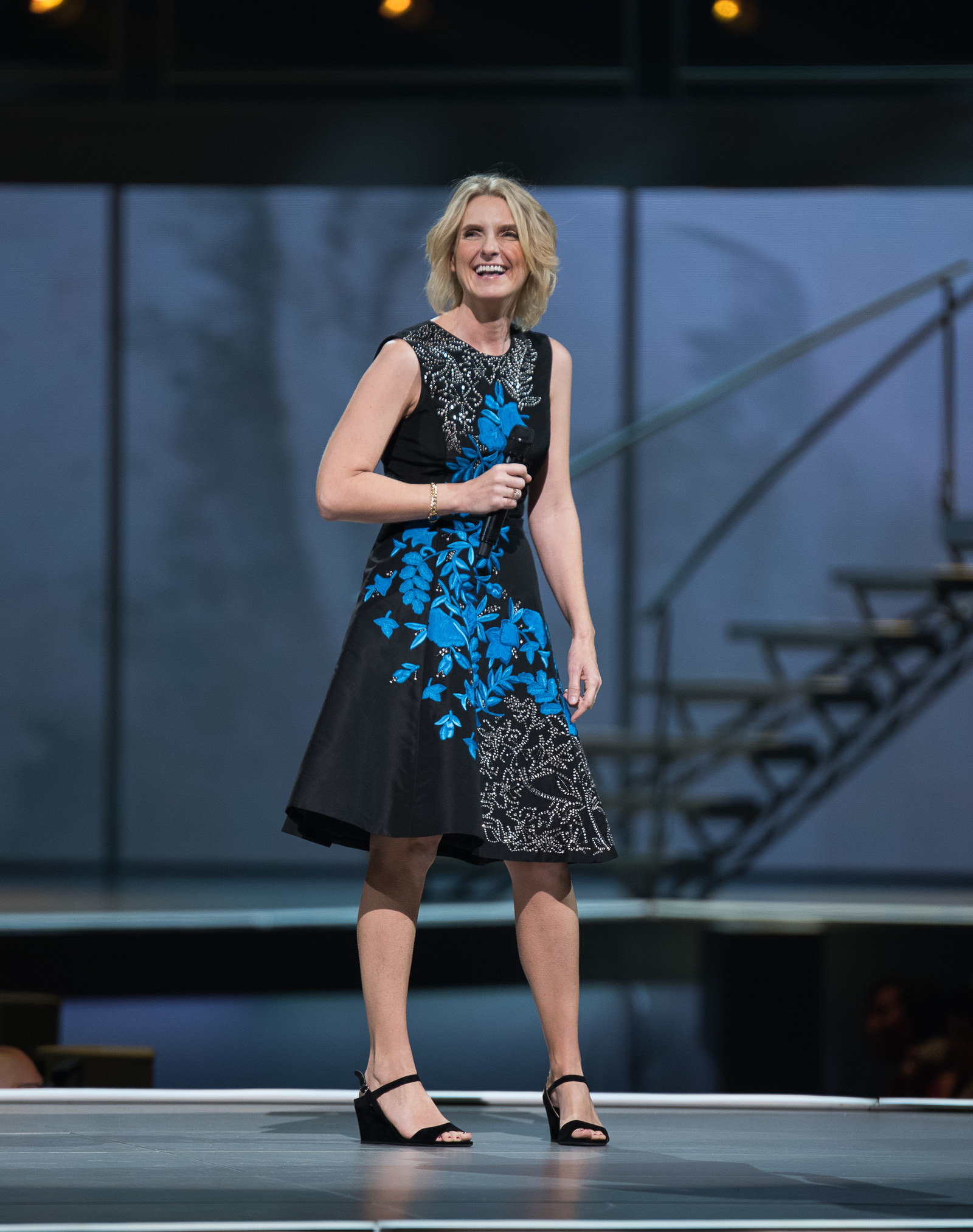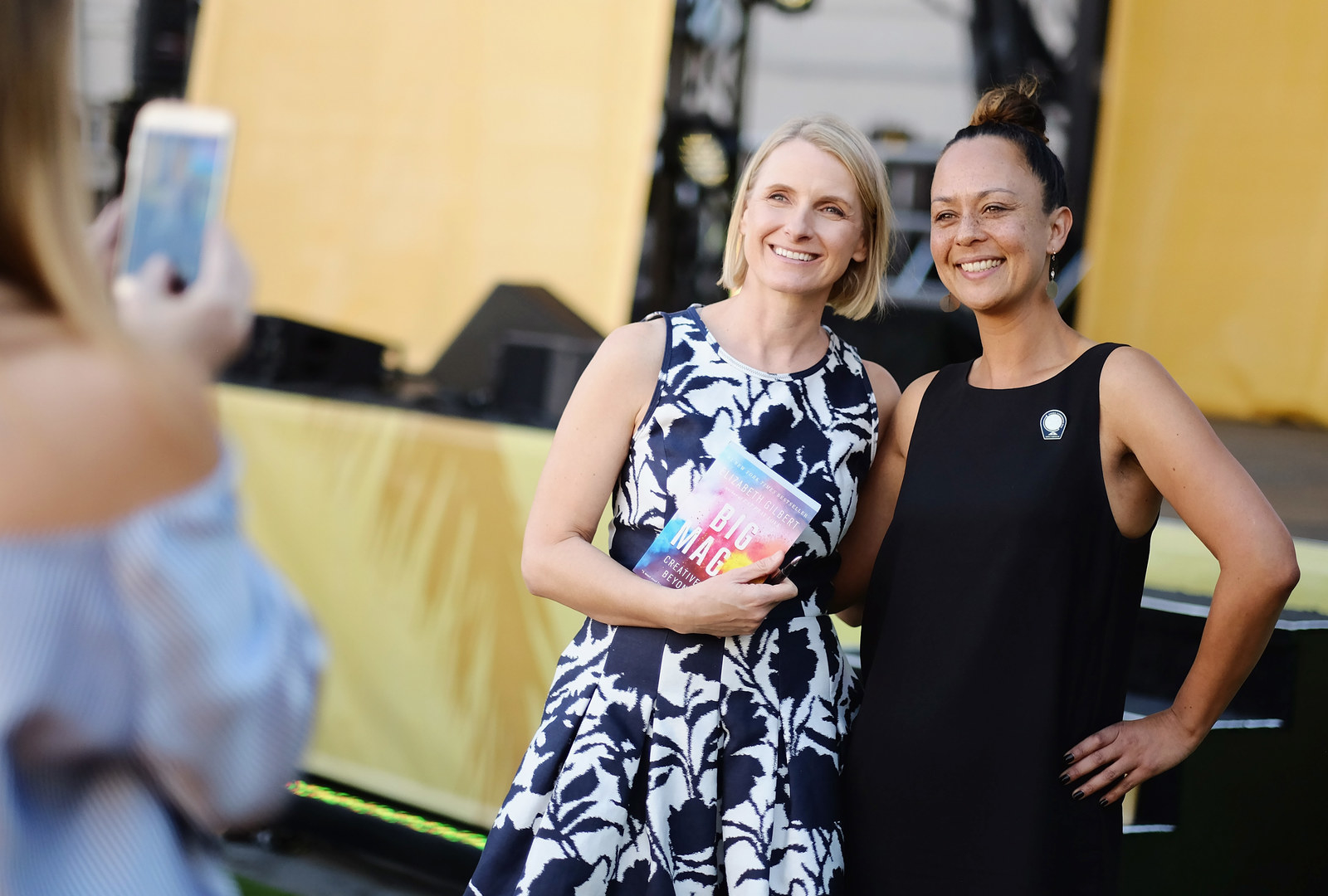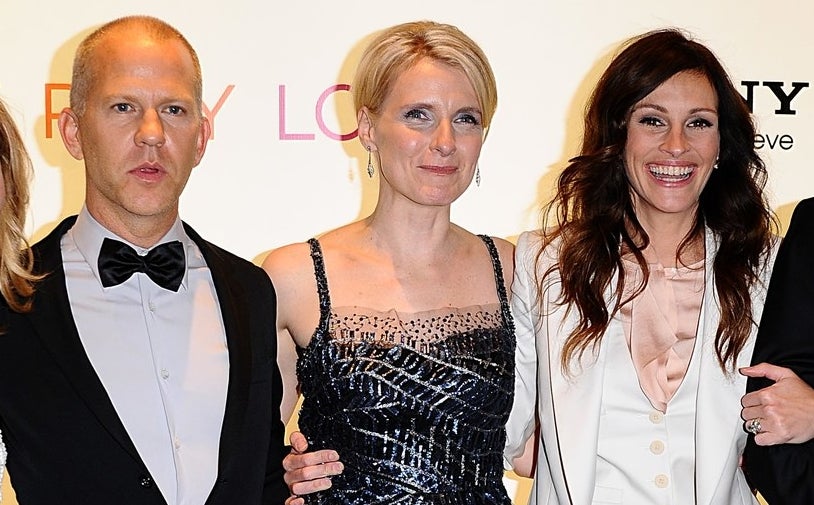Elizabeth Gilbert has recently taken up dancing.
Not the graceful steps she might have retained from a childhood ballet class, which she assures me she never took. It’s much less dignified than that. Gilbert dances with the loosey-goosey, arms-akimbo, leaving-everything-out-on-the-floor abandon you discover when you’re dancing in a room by yourself to Motown.
“I do a lot of weird shit on my own,” she tells me with a laugh. “Most people like us,” she gestures to me, so I assume she means writers more generally, “think of our bodies as a broomstick that carries our brain jar around.”
Over the last year, movement has been an important way for Gilbert to break herself free of this mindset. But the dancing? That started as a way to cope with the loss of her partner, Rayya Elias, who died in 2018 of pancreatic and liver cancer, at age 57.
“I have this beautiful memory from when right after Rayya was diagnosed,” Gilbert says. “We’d been crying a lot, and some David Bowie came on. I just remember her looking at me, and she just started smiling, and she was like, ‘Well, we might as well just dance.’”
Elias, a musician, filmmaker, and author of Harley Loco: A Memoir of Hard Living, Hair, and Post-Punk, From the Middle East to the Lower East Side, seems to be on Gilbert’s mind that day.
“I can still see her face, still see that Oh, I’m dying and we can dance,” says Gilbert. “In the months after Rayya died, I would just hit shuffle on one of her playlists and be like, babe, you pick it, and then I would dance to one of her songs.”
In an indirect way, Elias happens to be the reason Gilbert, now almost 50, has chosen our meeting spot, Ludlow House, an upscale private club and coworking space in SoHo.
After Elias was diagnosed with cancer, Gilbert, who grew up in Connecticut but has lived in Manhattan on and off for the past 30 years, needed somewhere else in the city to be, where she could retreat when grief and caretaking got overwhelming. Ludlow House, with its low-slung red velvet couches where members can huddle with open laptops beneath a painting of Lin-Manuel Miranda as Alexander Hamilton, presented a convenient solution.
She appears in the lobby wearing a leather motorcycle jacket to ward off a persistent mid-May rain, a turtleneck sweater with inviting pockets, loose velour pants, and a sturdy pair of boots. “T.J. Maxx, head to toe,” she says, posing gamely.
“I can still see her face, still see that Oh, I’m dying and we can dance.”
Gilbert is tall, but she swoops down and embraces me firmly, though we’ve never met, and almost immediately compliments my bangs. Her own hair has changed. It’s no longer the blonde, Meg Ryan–esque tangle immortalized on the back flap of 2006’s Eat, Pray, Love, but a sleek and angular bob that Gilbert ruffles and parts periodically as she speaks. It seems to me the bob of a woman who has spent the last six years immersed in a novel about the theater world of 1940s New York, which she has.
City of Girls is Gilbert’s third novel and eighth book. It’s her New York book, an ode to the “mirrored skyscrapers, neon signs, and shining wet streets” of the city as it teeters on the edge of World War II, a love song to the entrancing chaos of Times Square, with “mountains of artificial lights” that “spewed out their lava of white-hot news and instant advertising.”
One of the great pleasures of City of Girls is that it takes women seriously — women whose lives might otherwise be passed over for being too frivolous, on the one hand, or too transgressive, on the other. The beating heart of the novel, out now, is Vivian Morris, an octogenarian reminiscing about her glory days at the behest of a young woman who wonders what Vivian meant to her father, way back when. We meet Vivian in 1940, a 19-year-old Vassar College dropout sent packing to her Aunt Peg, owner of a crumbling Midtown vaudeville joint called the Lily Playhouse, where leggy showgirls seek regular work and the audiences are work-a-day folk who don’t mind if the shows are second-rate. The point is that there are shows.
Energized by the freedom of the women around her, Vivian jumps into the fray, offering her skills as a tailor to create costumes out of scraps and enjoying as many sexual encounters with men as she pleases.
Writing a woman character who enjoys a life of pleasure “without ruination,” says Gilbert, is what first drew her to Vivian’s story. “I wanted to talk about how you can survive your own consequences, because I think there’s a generalization in classical literature that women’s consequences cannot be survived,” Gilbert says.
We joke briefly about being thrown under the wheels of a train à la Anna Karenina, or shunted off to a convent for bad behavior. “I think there’s a story that runs in our own lives, which is like, it’s OK to have a certain season of your life when you’re young and and where you’re sexual,” she says, “but then you had really better settle down into a heteronormative, monogamous relationship.”
“I didn’t want that to be the ending of the story, either, because I think that most of the sexual lives of most of the women I know are just more complicated than that,” she adds.
Indeed, the sex in City of Girls is plentiful, exploratory, and — just once — queer. (It’s a threesome, but Vivian has long admired Celia, a showgirl and “the kind of woman who smoldered even when she wasn’t intentionally trying to smolder.” Everyone at the Lily Playhouse more or less assumes the two fast friends have already slept together.)
I list all the romantic and sexual relationships that I can think of in the novel, since it covers a lot of ground: casual sex, monogamy, romantic friendship, queer partnership, conventional hetero marriage.
“I’ve done them all!” Gilbert says, laughing hard into her decaf cappuccino. “That was the one part of the book I didn’t have to do any research on.”
“They say that all novels are memoirs,” she continues. “So, to a certain extent, this is a memoir for me. It’s a book about female sexual desire and shame.”
“We’ve got these built-in, hardwired desires. They bring problems. What are you going to do about the problem of sex? I love to look at how people have solved it,” says Gilbert.
The modern version of professional and social ruination, however, came to the fore for Gilbert as she watched #MeToo allegations roll out in 2017. She worried that the “long-overdue” shift in attitudes about sexual harassment might affect the way she wrote about the sexual politics of the ’40s.
“One of the things I can’t bear in historical fiction with strong female characters is when they are prematurely woke,” says Gilbert. “You know, they’re like a scullery maid in the 17th century, but they have ideas as if they have a master’s degree in women’s studies from Barnard.” She laughs.
“You can be strong and you can be independent, but you can’t be a feminist yet. You don’t have that power,” she continues. “You have to find other ways for her to be strong, but they can’t be by our metric.”

For Gilbert’s characters, contending with the problem of sex often results in radical reckonings with who they are, what they want, and what they’re willing to give up to get it.
“Vivian knows, I need to have anonymous sex with men pretty frequently, and I’m going to build my life around that. Vivian chooses freedom over safety,” she explains. “There’s a line in there, she says, ‘I would rather be free than safe,’ which I think is also a very important line during the #MeToo movement. Her choice is, I’ll take that risk. I’ll put myself out there and risk having bad experiences so I can be free.”
“They say that all novels are memoirs. So, to a certain extent, this is a memoir for me. It’s a book about female sexual desire and shame.”
While Vivian doesn’t experience violence or sexual exploitation, one of the most severe consequences she faces is for that ill-advised threesome, which almost wrecks her reputation. Although she finally has the chance to explore her desire for Celia, Vivian betrays one of her dearest friends in the process, the glamorous stage actor Edith Parker Watson.
Edith dresses Vivian down in a speech that haunts her for the rest of her life: “The thing that you don’t understand about yourself, Vivian, is that you’re not an interesting person. ... You are the type of woman who cannot be a friend to another woman, Vivian, because you will always be playing with toys that are not your own.”
In her characteristic openness, Gilbert has already addressed how desire occasionally put her on a crash course for affairs and adultery. In a 2015 essay for the New York Times called “Confessions of a Seduction Addict,” she writes, “If the man was already involved in a committed relationship, I knew that I didn’t need to be prettier or better than his existing girlfriend; I just needed to be different.”
After detailing her attempts to put a stop to self-destructive behavior, she continues: “For the first time, I forced myself to admit that I had a problem — indeed, that I was a problem. Stealing other women’s boyfriends didn’t make me a revolutionary feminist; it just made me a menace.”
“I’ve had reckonings. I’ve had to sit in rooms with people who I’ve hurt.” Gilbert tells me. “That’ll wake you up. It should. It should call you to your own attention.”
“I think I’m at an age where I don’t really care,” she says, when I ask whether she feels vulnerable admitting the book hits so close to home. “I’ll be 50 in a month. I just feel like, well, let’s open it up.”

You can find the seeds of Gilbert’s 30-year obsession with sexual freedom in her 1997 short story collection, Pilgrims. The last piece in the book, “The Finest Wife,” is a kind of sexual ghost story in which Rose, a 70-year-old school bus driver, picks up all her old lovers while executing her morning route. She rattles down dirt roads in a bus designed for kindergartners, remembering fondly everything her lovers taught her in bed while the men bump amiably along next to one another, greeting one another in turn.
Gilbert’s previous two novels, 2000’s Stern Men and 2013’s The Signature of All Things, both follow strong-willed women who forge their own paths in societies that aren’t quite ready for them to do so. While all three novels are coming-of-age stories, City of Girls is Gilbert’s first novel that dives deep into lust and what makes wanting, as a woman, so complicated. That’s why she wanted to show “not a consequence-free life,” Gilbert stresses of Vivian’s choices and stumbles, “but a life where you can survive your own choices.”
“I’ve had reckonings. I’ve had to sit in rooms with people who I’ve hurt.”
City of Girls is also the first novel Gilbert has ever written as a kind of riposte to her critics. Despite her successful career as a journalist and novelist, she’s had to navigate a suspicious side-eye from readers and critics who felt the topics she explored in Eat, Pray, Love, and her follow-up 2010 memoir, Committed, were beneath her abilities.
In 2013, she published her novel The Signature of All Things, cementing her reputation as a literary juggernaut. At the time of publication, however, Gilbert told the New York Times Magazine she was fed up with the implication that she should court more “serious” readers (read: men), instead of the largely women audiences drawn to her memoirs. “I want to say: ‘Go [expletive] yourself!’” she said then. “‘You have no idea who the women are who read my books, and if I have to choose between them and you, I’m choosing them.’”
If anything, Gilbert’s feelings have crystallized in the intervening six years. “It’s a little bit of a double middle finger,” Gilbert admits, when I ask her about the relationship of City of Girls to the Times quote. Her laughter is wry. “I will not have you tell me that women’s lives don’t matter. I will not have you tell me that women readers aren’t as important as male readers. That’s fucking ridiculous.”
City of Girls is a confection — it’s breezy, but controlled, and it tackles the darkness of the 1940s without veering too far from the dazzling lights of the Lily Playhouse. Gilbert takes Vivian’s choices seriously, but she has also deliberately left the prose style of her early fiction behind.
“I know it was a little insouciant to be like, I dare you! I dare you to call this chick lit!” she adds. “But whatever. Call it whatever you’re going to call it. Just read it. Or don’t.”

Decades before Gilbert’s work received the blockbuster movie treatment, Gilbert was a sought-after features writer for GQ and Esquire in the late ’90s and early 2000s. Her chronicles of the regulars at Coyote Ugly Saloon, a bar in the East Village, were immortalized in a cult film starring Piper Perabo and Tyra Banks. In a profile nominated for a National Magazine Award, she charted the rise of Hank Williams III as he blustered and cussed his way through Nashville. Her profile of Eustace Conway, a modern-day mountain man, earned her a contract for what would become her first book of nonfiction, 2002’s The Last American Man.
“The path that I took is no longer available,” Gilbert says of her early journalism career. “Coming up through magazines — can’t do it. Can’t make a living at that anymore. Can’t get your short stories published in Esquire anymore. All those doors are closed, you know?”
Gilbert is so used to balancing her creative work with the work that makes her money that the idea of separating her writerly identities into neat packets — fiction and nonfiction — doesn’t add up. “For my whole life, it was always the thing in the background,” Gilbert says of her fiction writing. “Because it was such a long time before I made a living as—”
She doesn’t complete the sentence, but she doesn't need to. “My whole life, writing has been the background music on the radio in the other room. That radio is always on.”
The book that made Gilbert famous — the one that’s so big that she doesn’t even need to name it — is also the one readers and critics reference the most casually. Her 2006 memoir Eat, Pray, Love not only defined her career, but it also cemented Gilbert into pop culture in a way that writers almost never are.
“I will not have you tell me that women readers aren’t as important as male readers. That’s fucking ridiculous.”
In the 13 years since its publication, Eat, Pray, Love has shape-shifted from a freak publishing phenomenon to a cultural touchstone for middle-aged (mostly white) women to, just as quickly, a joke — either about middle-aged white women or about their particular cultural blindness — tinged with a kind of mean-spirited irony that Gilbert doesn’t seem to possess, either in person or on the page.
It generated almost as many thinkpieces about tourism, insensitivity, and cultural appropriation as it did essays from other women who shared Gilbert’s yearning: for escapism, for absolution, for romantic freedom, for a brand-new life. Riverhead even published a companion volume of these pieces, Eat Pray Love Made Me Do It, in 2016.
“I think that what happened with Eat, Pray, Love — I mean, there are people who were deeply offended by that book, for so many reasons that are all valid,” says Gilbert.
“It got to be one of those books that got so well-known that you kind of had to read it so that you were up on the culture,” she continues, “which meant that it ended up in a lot of hands that it never should’ve been in. Of people who would hate that shit. And they hated it!” (The glamorous 2010 movie adaptation starring Julia Roberts only complicated things further by leaning into “white lady travels to South Asia” tropes instead of examining them.)
“If you yourself are a very deeply private person, or if you’re an atheist, or if you hate memoir, there’s so much that you could hate,” Gilbert says of her memoir, which is far more nuanced than the film. “If you hate privileged white ladies, there you go. There’s no end of stuff to hate, so I know that that’s out there.”
“I’m not going to go into your mind and steal your opinion about what you think I am. You get to have that, and I get to keep doing what I do,” Gilbert continues, when asked if she thinks there’s a public misconception about who she is. “If I had to clear it with everyone first — there’s too many of you!” she laughs. “Talk about governing by committee.”

The hoopla generated by Eat, Pray, Love allows Gilbert to possess the financial freedom and the cachet she does now, and she knows it. She does, however, contend that she’s not a brand.
“Every day I get to decide, on that day, what I want to talk about, and what I don’t want to talk about,” says Gilbert, who has no personal assistant or social media manager. “And that is based on the day. I mean, it’s an instinct. It’s jazz. It’s improvisation.”
Since the publication of her last book, 2015’s Big Magic, Gilbert has also transformed into a kind of spiritual and creative guru, bolstered by the support of Oprah, Super Soul Sunday, and her friendships with other white self-help megastars on the Oprah circuit, like Brené Brown and Glennon Doyle.
Something that Brown writes about vulnerability strikes Gilbert as especially true. “You don’t write from your open wounds, you write from your scars,” she recites. “Because if you write from your open wounds, and you put it out there in the world, then you really have made yourself vulnerable, because you’re still bleeding.”
“I’m not going to go into your mind and steal your opinion about what you think I am. You get to have that, and I get to keep doing what I do.”
“But if you show people your scars, you’re like, look, it’s my scar.” Gilbert pushes up the sleeve of her sweater to reveal a tattoo on her left wrist. “Oh, you have ’em too? Here, look.” She pushes up her other sleeve, holding both arms out to me, cradling the air.
Gilbert’s approach to art, healing, and writing without fear draws hundreds of participants to creativity workshops, which she headlines with blockbuster writers like memoirist and beloved internet advice guru Cheryl Strayed, the author of Wild, whom she also counts as a friend. “I’m a very extroverted person, for a novelist. I like to engage,” Gilbert says. “One of my favorite things to do that I’ve ever done in my life is to teach this workshop. I love helping people get free.”
The workshop leapfrogs off the beliefs Gilbert laid out in Big Magic, which exists somewhere on the spectrum between spiritualism, writing advice, and self-help. “Creativity is a realm where I’ve always felt free. It’s always been my playground, and I see so much pain in the world around it, and so much suffering,” says Gilbert. “With Big Magic, I felt like, god, can I help you get on the other side of all these fears and obstacles? I would love to, because, if you can, you’re going to have so much more fun. It’s just helping people get on the other side of fear, which is always the thing that stops creativity. Only always.”
“Make the thing you want to make,” she continues. “Because when you start overthinking questions about the current political climate, the current state of publishing, how many books are reviewed by women versus how many books are reviewed by men, where the awards go, privilege, race, all of it — it’s such a swamp. Don’t let any of that stop you from making the thing you want to make.”
I didn’t come here to sit at the feet of Gilbert the guru — I really didn’t. But then Gilbert leans forward suddenly and shakes me by the shoulders. “Make the thing you want to make!” she whispers, her voice low and fierce, almost as if she’s casting a spell. As if she can see all the way through the laptop bag I’d slung on a chair at the beginning of our interview, straight to the unfinished drafts on my hard drive, which I have not mentioned, not once.
Who am I not to listen?

When she talks, Gilbert makes sustained and direct eye contact. She leans her head on her hand, or loops them underneath her thighs, as she stretches and settles into a yogic pretzel.
She’s never not trying to connect, except, perhaps, when she’s dunking the sugar cookie that accompanies her cappuccino into the foam and licking her fingers clean.
Occasionally, something reminds her of Elias, like a line she gave to Vivian in City of Girls about being able to get a job anywhere by bringing her scissors and showing them what she can do. (Elias cut hair professionally; Vivian designs everything from showgirl costumes to wedding gowns.)
But, says Gilbert, City of Girls isn’t Elias’s book. “I wrote it so immediately after her death, and I needed to have a place for my mind to go that wasn’t Rayya,” Gilbert explains. “Because certainly every other moment of the day was. The book was almost an escape from that grieving.”
“There’s no character that’s like her, and there almost wouldn’t have been,” she continues. “Rayya was a very modern, glamour butch lesbian. I can’t find her equivalent in 1940. When the time comes that I do write about Rayya, whether it be in fiction or nonfiction, it has to be contemporary. She just can’t exist before when she existed.”
Her voice softens. “She’s not really in here. But someday she’ll be in something. I’m still bleeding on that one. I’m not ready to show the scars.” ●
Illustration by Allegra Lockstadt for BuzzFeed News.
Kristen Evans is a critic and culture writer who has written for BuzzFeed, the Los Angeles Times, LA Weekly, the New Republic, Nylon, and elsewhere.

